Itwas the kind of scene you’d expect to see on the North Shore of Oahu or the Gold Coast of Australia: three surfers bobbing in the water as a 4.6m swell rolled in. One of the surfers paddled into it, snapped to his feet and suddenly he was riding it — millions of liters of the ocean’s energy barreling him forward. He turned, speeding left, flipping right, then crouched down and held the sides of his board, launching himself 1.5m off the crest. He flew, spinning into the air, drops of water fanning him like white lace, and landed with perfect ease on the wave as it settled back down and lapped toward shore.
Only this wasn’t Pipe, Indo or any other famous moniker the world’s nomadic surfing community bestows on its favorite pilgrimage spots. This clean, perfect, enormous wave was rolling in to a little-known surf destination — the east coast of Barbados. And the only audience that these three surfers — professionals from Hawaii and Florida in town to shoot a documentary for billabong — had was an empty, palm-tree-lined beach.
Tucked in the southern corner of the Lesser Antilles, Barbados is the easternmost island in the Caribbean. The island’s west coast is its famous side: powdery beaches, water as clear as if it were poured from a tap, manicured estates, really manicured resorts and even more manicured golf courses. That part of the island is known as the Platinum Coast, so named for the color of its sparkling coastline and its preferred credit cards. That is the Barbados of the travel agencies and guidebooks. But it’s only half the story.
The eastern coast of Barbados is a whole other world. Sequestered from the posh resorts by hectares of sugar cane fields, thick, verdant forests and trees full of wild monkeys, this is Barbados’ rougher side. “You could spend all your time in the west and never know the real Barbados,” said Melanie Pitcher, a surfing instructor and owner of Barbados Surf Trips. “The east is run by the locals, not the tourists.”
The main town on this side is Bathsheba. Bathsheba looks as if it was once the playground of mythical creatures — enormous limestone boulders are casually strewn in the shallows, as though giants were playing catch and paused for a break. The wind barrels in relentlessly off the Atlantic, sweeping the hillside and everything with it: the mountain face is hollowed by the warm blasts, palm trees arch backward, their seaside fronds thinned from the constant howl, waves endlessly roll in from the vast ocean. It’s a coastline carved by centuries of wind blowing from thousands of kilometers away, great gusts of salty air like tempests heaved by the gods.
With isolation, of course, come characters. This is a place where people have names like Buju, Yellow and Chicken. Where you pay deference to Snake, the founding father of Barbados surfing. Where people know to avoid “dropping in” on Smoky’s wave if he’s having a bad day.
But the real celebrity in town is Soup Bowl, the island’s biggest wave. “When soup Bowl is good, it gives you goose bumps,” Pitcher said. We were sitting on the deck of the sea side bar on the main (well, only) road in town, finishing a lunch of fried flying fish with rice and beans, watching the swells curl into massive walls of water. There were no surfers out, but a few people were sitting on the shoreline taking in the show. “When it’s breaking clean, people come here after work and stand on the beach to watch. It’s pure magic.”
On a map, Barbados looks as if it is drifting out into the open Atlantic, which is exactly what makes Soup Bowl ideal. A wave can travel nearly 4,830km in the open ocean, undisturbed by sandbars, reefs or land, before it breaks here — on an unlikely little island shaped like a teardrop, off the radar of all but the most devoted surfers.
“I’ve been going for over 20 years, and I’d put Soup Bowl as one of the top three waves in the world,” said Kelly Slater, the Tiger Woods of surfing, who recently won his ninth world championship. “It’s got a really good curve and allows all sorts of maneuvers and airs. The only problem is that there are sea urchins all over the bottom — just don’t fall and you’re fine.”
Aquatic life here isn’t just for world champions, professional athletes and people who claim they could surf before they could walk. Much of the eastern and southern coasts already have the trappings of a laidback surfer town — makeshift beer bars, street food vendors selling fried fish and cheap guesthouses with blue painted walls — that are so appealing to people who prefer to watch surfing than wax up a board. But, as the locals will remind you again and again: What makes Barbados unique is that there is a wave for everyone.
“Anyone can surf Barbados, and I mean anyone,” said Zed Layson, owner of Zed’s Surfing Adventures, one of the bigger surf schools on the island. (Bigger is a relative term — Layson has one employee, another surfing instructor named Junior.) Layson is exactly what you’d want your surfing instructor to look like: shaggy blond hair, sunburned nose and cheeks, bright blue eyes and a lopsided, easygoing grin. He’s Barbadian by way of Jeff Spicoli. “Our smaller waves are the most consistent. You can close your eyes and point to the calendar — any day you hit, Barbados will have great beginner and intermediate waves.”
Layson is fifth-generation Bajan — and may be one of those people who could surf before he could walk. “We have 35 surf breaks on this island and Soup Bowl is only one of them,” he told me over breakfast at Surfer’s Point, a popular break on the southern end of the island. We were watching the morning windsurfers assemble their gear on the sand. “We can teach anyone,” he said. “You know those fat Wall Streeters who can barely walk but suddenly have lots of free time and US$400 million in the bank? Yes, I can even get them standing on a board by their second lesson.”
On a blazingly sunny day, the third in a row of my visit, I made my way to Silver Sands, where the Atlantic Ocean meets the Caribbean Sea on the southern tip. The coastline alternates between carved-out bays, sheltered from the wind and perfect for surfing, and the rougher points where the wind can lift a kitesurfer 9m off the water. This is Brian Talma’s stretch of sand. Talma, owner of deAction Beach Shop is famous in Barbados. A professional windsurfer for almost 20 years, he is also widely credited for the rise of surfing on the island, and has a habit of saying “Action!” in place of phrases like hello, goodbye and nice to meet you.
“Action! Do you want a drink?” Talma said. We were on the outdoor deck of his shop at the end of the day, watching a group of kitesurfers laying down the Technicolor swaths of nylon to dry in the setting sun. “Listen,” he continued. “If I say Jamaica, you think reggae, right? But when I say Barbados, nothing comes to mind, and that has to change. The government has to market Barbados as an active beach culture.” Of course, Talma is also mindful of that surfer’s caveat: Popular is good; too popular is dangerous. “More people are surfing here every day, and we’re at the point right now where we have to find that balance,” he said.
In the boom economy, surfers had a knack for seeking out the untouched, raw, beautiful seascapes that no one knew about. Once the surfers found them, the developers were hot on their trail, and soon someone like Ian Schrager or Philippe Starck would open shop, followed by people with high heels and lapdogs. And before you knew it, beaches from Fiji to Mexico to Costa Rica became crowded, expensive and very much discovered.
“When you see bumper stickers in Oahu that say, ‘Tourist, go home,’ that’s a problem,” Talma said. “And that’s not us. But locals have to be strong or we’ll lose our culture, just like Hawaii has.”
Not everyone is thrilled by the prospect of luring the masses. “It’s a tricky situation,” said Alan Burke, owner of Burkie’s Surf School. He was pulling boards out of the back of his truck, getting ready for his afternoon students — half a dozen boys between the ages of 8 and 11 who would be arriving momentarily to practice for the island’s first juniors competition the following week. “On one hand you want people to come here and surf, and on the other hand you don’t want it to be a zoo.”
Burke, a former professional surfer, has traveled to every major surfing destination and knows the risks that come with geographic fame. “Look at Soup Bowl,” he said. “It could be every bit as famous as the north shore of Hawaii, but do we want that? That’s what’s good about being a small, sheltered island. I bet people in Hawaii wish they stayed a little more sheltered.”
The good thing about being relatively undiscovered is that there was no tourism bubble here to burst. “The recession has hit the west coast,” said Layson, who charges US$80 for a two-hour lesson. “But we haven’t seen any change in the surfing world here. It’s still cheap compared to other places in the world. Wait, inexpensive, not cheap. Cheap sounds like it’s not quality surfing, which it is.” Whatever you call it, Soup Bowl may be the least costly, world-class wave on the planet.
On the Net: www.barbadossurf.com; www.surfbarbados.net; www.surfbarbados.com

Under pressure, President William Lai (賴清德) has enacted his first cabinet reshuffle. Whether it will be enough to staunch the bleeding remains to be seen. Cabinet members in the Executive Yuan almost always end up as sacrificial lambs, especially those appointed early in a president’s term. When presidents are under pressure, the cabinet is reshuffled. This is not unique to any party or president; this is the custom. This is the case in many democracies, especially parliamentary ones. In Taiwan, constitutionally the president presides over the heads of the five branches of government, each of which is confusingly translated as “president”

Sept. 1 to Sept. 7 In 1899, Kozaburo Hirai became the first documented Japanese to wed a Taiwanese under colonial rule. The soldier was partly motivated by the government’s policy of assimilating the Taiwanese population through intermarriage. While his friends and family disapproved and even mocked him, the marriage endured. By 1930, when his story appeared in Tales of Virtuous Deeds in Taiwan, Hirai had settled in his wife’s rural Changhua hometown, farming the land and integrating into local society. Similarly, Aiko Fujii, who married into the prominent Wufeng Lin Family (霧峰林家) in 1927, quickly learned Hoklo (commonly known as Taiwanese) and

The low voter turnout for the referendum on Aug. 23 shows that many Taiwanese are apathetic about nuclear energy, but there are long-term energy stakes involved that the public needs to grasp Taiwan faces an energy trilemma: soaring AI-driven demand, pressure to cut carbon and reliance on fragile fuel imports. But the nuclear referendum on Aug. 23 showed how little this registered with voters, many of whom neither see the long game nor grasp the stakes. Volunteer referendum worker Vivian Chen (陳薇安) put it bluntly: “I’ve seen many people asking what they’re voting for when they arrive to vote. They cast their vote without even doing any research.” Imagine Taiwanese voters invited to a poker table. The bet looked simple — yes or no — yet most never showed. More than two-thirds of those

In the run-up to the referendum on re-opening Pingtung County’s Ma-anshan Nuclear Power Plant last month, the media inundated us with explainers. A favorite factoid of the international media, endlessly recycled, was that Taiwan has no energy reserves for a blockade, thus necessitating re-opening the nuclear plants. As presented by the Chinese-language CommonWealth Magazine, it runs: “According to the US Department of Commerce International Trade Administration, 97.73 percent of Taiwan’s energy is imported, and estimates are that Taiwan has only 11 days of reserves available in the event of a blockade.” This factoid is not an outright lie — that